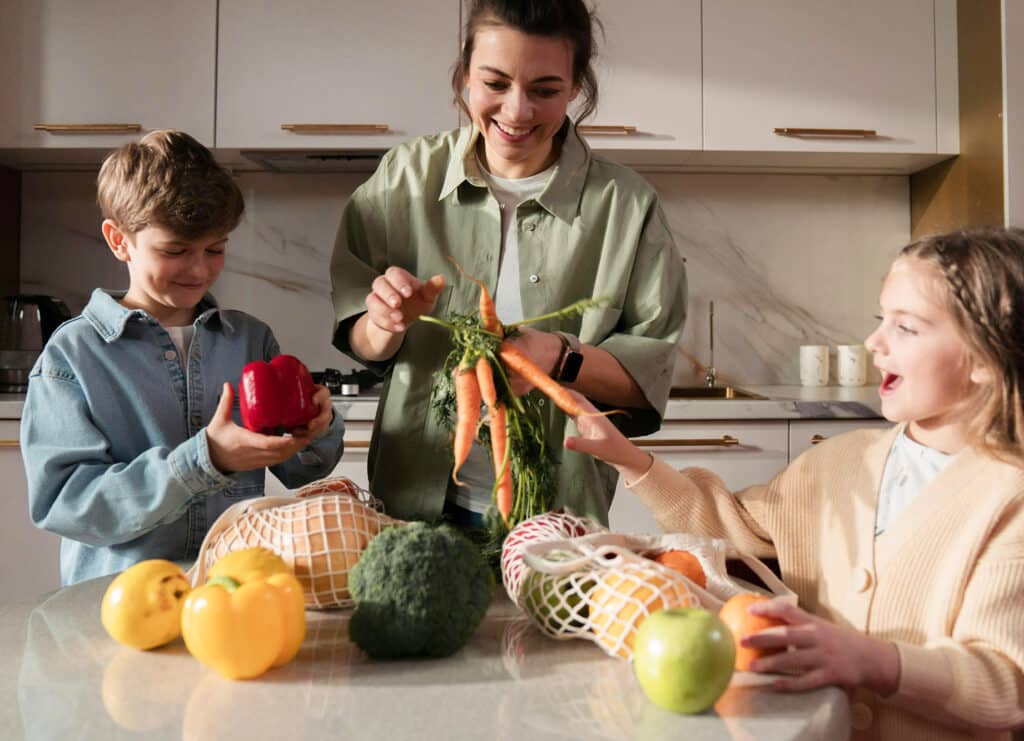Celebrating National Nutrition Month

March is National Nutrition Month, a perfect time for early educators to instill healthy eating habits in young children. Preschoolers are at a crucial stage where they begin developing lifelong preferences and attitudes toward food.
Research shows that children who eat a balanced diet rich in fruits, vegetables, and whole grains are more likely to maintain a healthy weight, have stronger immune systems, and perform better academically. Additionally, proper nutrition reduces the risk of developing chronic illnesses such as diabetes and heart disease later in life.
Studies have also shown that young children who eat nutritious meals are less likely to experience behavioral issues and have improved focus and concentration.
Ensuring that preschoolers have access to healthy foods not only supports their physical development but also enhances their cognitive and social growth.
As an early childhood educator, I have seen firsthand how incorporating nutrition into the classroom can make a significant impact on young children. When I started including more conversations about healthy eating, modeling nutritious choices, and engaging children in food-related activities, I noticed that students became more curious and excited about trying new foods.
One of my favorite moments was when a child who had never eaten a green vegetable before proudly tasted a cucumber slice and exclaimed, “It’s crunchy like a chip!” Small experiences like these show the power of early exposure to nutrition in shaping children’s attitudes toward food.
Here are some creative and developmentally appropriate ways to celebrate National Nutrition Month in your classroom:
Create a Classroom Farmers’ Market
Transform your dramatic play area into a farmers’ market where children can “shop” for fresh fruits and vegetables. Provide play money and baskets, allowing children to explore different types of produce, practice counting, and learn the names of various healthy foods.
Rainbow Food Exploration
Encourage children to try a variety of colorful foods by creating a “Rainbow Plate” challenge. Each day, introduce a fruit or vegetable of a different color and discuss its benefits. Use books and visuals to reinforce the idea that eating a variety of colors helps keep our bodies strong and healthy.
Healthy Snack Preparation
Engage preschoolers in making simple, healthy snacks like fruit kabobs, veggie wraps, or yogurt parfaits. Let children participate in safe food preparation tasks such as washing produce, spreading nut-free butters, or assembling their own snacks. This hands-on activity promotes independence and curiosity about food.
Food Group Sorting Game
Create a fun sorting game using printed pictures of different foods. Have children categorize them into the five food groups: fruits, vegetables, grains, protein, and dairy. This visual and interactive activity helps children understand balanced meals.
Garden in a Cup
Teach children where food comes from by growing a mini garden. Use small cups or containers to plant easy-to-grow foods such as lettuce, carrots, or herbs. Caring for plants encourages responsibility while reinforcing the importance of fresh, whole foods.
Read Books About Nutrition
Incorporate read-alouds that highlight healthy eating habits. Some great books include:
• “The Very Hungry Caterpillar” by Eric Carle
• “I Will Never Not Ever Eat a Tomato” by Lauren Child
• “Eat Your Colors!” by Amanda Miller
• “Good Enough to Eat: A Kid’s Guide to Food and Nutrition” by Lizzy Rockwell
These books open up discussions about trying new foods and making healthy choices for National Nutrition Month.
Music and Movement: Food Songs and Dances
Sing songs about nutrition, such as “Apples and Bananas” or “Do You Like Broccoli Ice Cream?” by Super Simple Songs. Incorporate movement by playing a game where children act like different fruits and vegetables (e.g., stretching like celery, rolling like a blueberry). This reinforces learning while keeping kids active.
Nutrition-Themed Art Projects
Encourage creativity by having children make fruit and vegetable prints with paint, design their own healthy plates with magazine cutouts, or create food collages. Art helps reinforce concepts in a hands-on and enjoyable way.
Invite a Community Helper
Consider inviting a local dietitian, farmer, or grocery store worker to speak to the class about food and nutrition. Real-world connections help children understand the role of food in their daily lives.
Mindful Eating and Sensory Exploration
Encourage mindfulness by having children describe the textures, smells, and tastes of different foods. This sensory activity helps them slow down and appreciate what they eat, fostering a positive relationship with food.
Conclusion
Early educators play a vital role in shaping children’s attitudes toward nutrition. By incorporating these engaging and educational activities, you can help preschoolers develop a love for healthy eating that lasts a lifetime. National Nutrition Month is a great reminder to make learning about food fun, interactive, and meaningful. Happy teaching and happy eating!
Do you need to know more about how to add better nutrition to your Early Education Center? Make sure you check out our course on Children’s Nutrition.
